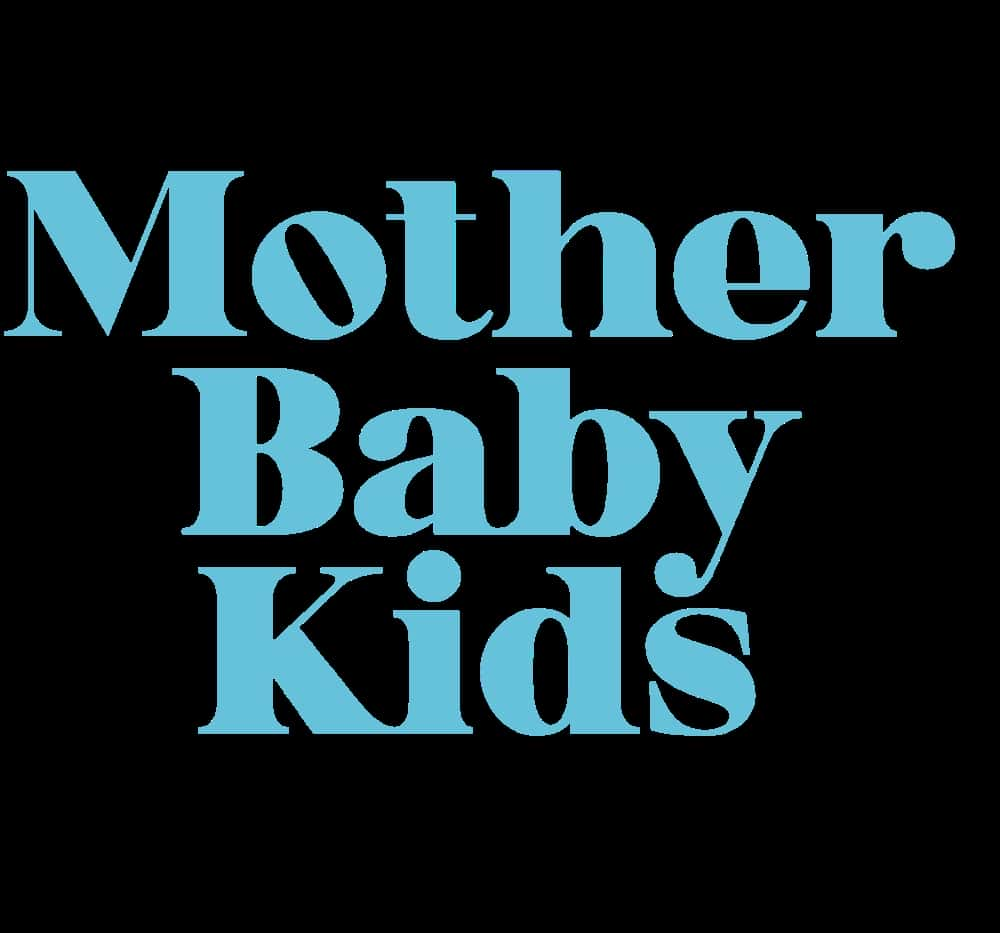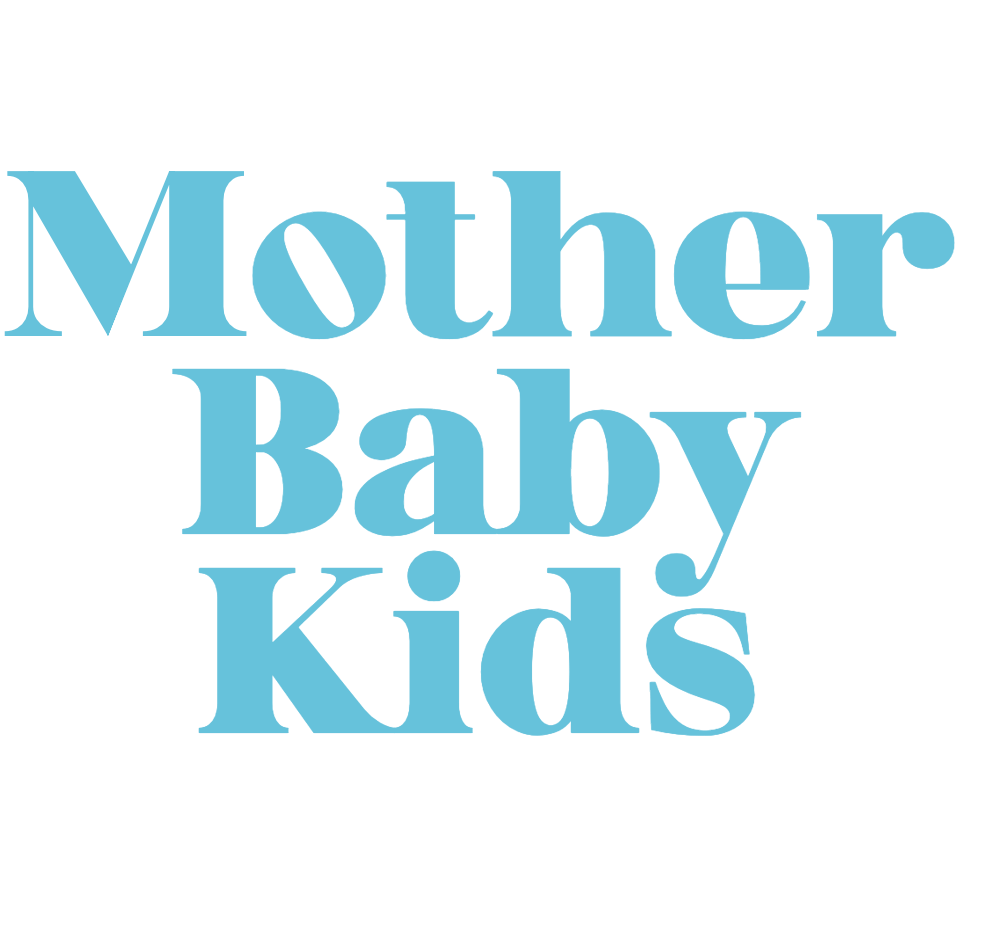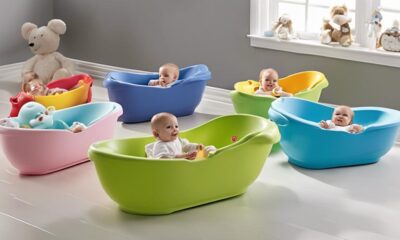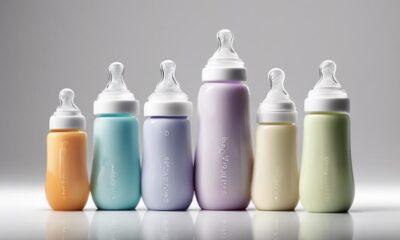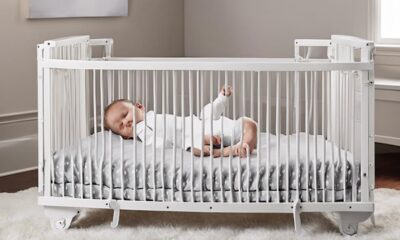Newborn Care
Essential Care Plan for Your Newborn
Overwhelmed with caring for your newborn? Discover the essential elements of an effective care plan that can ensure their well-being and development.

As new parents, we often underestimate the importance of providing proper care for our newborns. Were you aware that newborns need about 16 to 17 hours of sleep per day for their healthy development?
Understanding the essentials of a care plan is key to providing the best start for your little one. From feeding schedules to vaccination timelines, each aspect plays a critical role in their well-being.
Let's explore the intricacies of creating a all-encompassing care plan that can set the foundation for a lifetime of health and happiness.
Key Takeaways
- Establish a feeding schedule and monitor weight gain for proper nutrition.
- Introduce bedtime routines for quality sleep and develop nap schedules by 9 months.
- Practice good hygiene, care for the umbilical cord, and prevent diaper rash.
- Ensure timely vaccinations, monitor developmental milestones, and seek prompt intervention for delays.
Feeding Schedule and Nutritional Needs
In caring for your newborn, we must establish a feeding schedule that aligns with their nutritional needs and growth requirements. Whether you choose to nourish your little one with breast milk or formula, both offer important nutrients necessary for your newborn's development. Breast milk, in particular, provides essential antibodies and immune support that can bolster your baby's health.
To guarantee proper hydration, it's important to monitor your newborn's feeding frequency. Typically, newborns feed every 2-3 hours, totaling about 8-12 times a day. Adequate fluid intake can often be gauged by the number of wet diapers your baby produces. Additionally, keeping an eye on your newborn's weight gain is key to ensuring they're thriving and receiving enough nutrition.
Should you have any questions or concerns regarding your newborn's feeding schedule, don't hesitate to reach out to a healthcare provider or lactation consultant. These professionals can offer valuable guidance on feeding techniques and address any worries you may have about your newborn's nutrition.
Sleep Patterns and Routines

Establishing consistent sleep patterns and routines is essential for supporting your newborn's growth and development. Newborns require around 16-17 hours of sleep a day to aid their development.
Room-sharing, without bed-sharing, is recommended to reduce the risk of Sudden Infant Death Syndrome (SIDS). Creating a bedtime routine helps your baby anticipate and adapt to sleep patterns.
As your newborn reaches around 5 months, gentle sleep training methods can be introduced to assist with sleeping through the night. By 9 months, most babies naturally develop a nap schedule, often napping around 9 a.m. and 2 p.m., aligning with their sleep needs.
These routines promote healthy sleep habits and aid in your baby's overall well-being. Remember, each baby is unique, so it's important to be patient and attentive to your little one's cues as you establish a comforting and effective sleep routine.
Hygiene and Skin Care
To maintain your newborn's hygiene and skin health, daily cleaning of the genital area with warm water is essential. Here are some key tips to guarantee your baby's skin remains healthy and free from common issues:
- Care for the Umbilical Cord: Keep the umbilical stump clean and dry until it naturally falls off, usually within one to three weeks. Clean the area around it with warm water and mild soap, and make sure it's exposed to air to aid the healing process.
- Preventing Diaper Rash: Change diapers frequently and use gentle baby wipes or warm water to clean the diaper area. Applying a barrier cream can help prevent diaper rash, and giving your baby some diaper-free time can also aid in keeping the skin dry and healthy.
- Dealing with Cradle Cap: If your newborn develops cradle cap, gently massage their scalp with baby oil to help loosen the scales, and then wash their hair with a mild baby shampoo a few times a week. Avoid picking at the scales to prevent irritation and infection.
Vaccination Schedule and Immunization
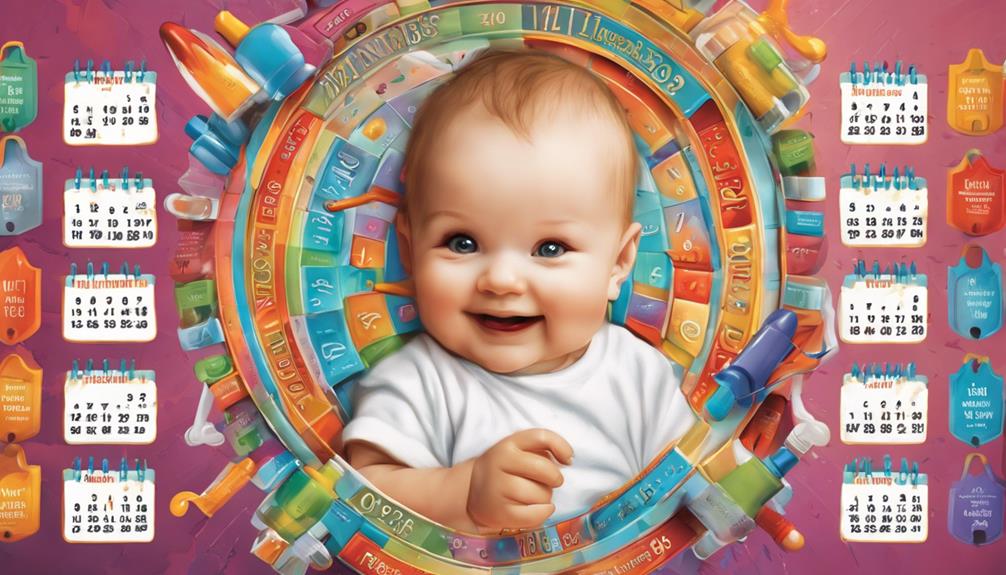
Let's explore the critical importance of maintaining a timely vaccination schedule and making sure proper immunization for your newborn. Immunizations play a vital role in safeguarding your baby's health by providing protection against serious diseases like hepatitis B, polio, and tetanus. By following the CDC's recommended vaccination schedule, you not only enhance your newborn's immunity but also contribute to preventing the spread of vaccine-preventable illnesses in the community.
It is important to have open discussions with your healthcare provider about any concerns or queries regarding vaccinations. Your provider can offer valuable insights to help you make well-informed decisions about your newborn's health. Remember, vaccines undergo thorough testing to ensure they are safe and effective for newborns. Prioritizing your baby's immunization is a proactive step towards promoting their well-being and the health of those around them.
| Vaccination Schedule | Benefits |
|---|---|
| Timely immunizations help protect against serious diseases | Boosts newborn's immunity |
| Prevents outbreaks of vaccine-preventable illnesses | Safeguards community health |
Developmental Milestones Monitoring
Monitoring your newborn's developmental milestones is essential for tracking their progress in key areas of growth and development. By observing these milestones, caregivers can identify any delays or concerns early on, allowing for timely interventions and support.
Here are three important aspects to take into account when monitoring your newborn's developmental milestones:
- Key Areas: Keep an eye on motor skills, communication abilities, social interactions, and cognitive development to make sure your newborn is progressing as expected.
- Identifying Delays: If you notice any delays in reaching milestones like lifting the head, making sounds, or grasping objects, consult with a healthcare provider promptly for guidance on interventions.
- Caregiver Support: Regular monitoring not only helps in tracking growth but also equips caregivers with insights to promote the best possible development and overall well-being in their newborn.
Frequently Asked Questions
What Is the Essential Care of a Normal Newborn?
We guarantee immediate assessment post-birth for your newborn's well-being. Apgar scoring at 1 and 5 minutes helps evaluate important signs. Physical exams are important for early detection of issues. Our care plans focus on nutrition, warmth, and development.
What Are the 4 Basic Needs of a Newborn?
We grasp the importance of meeting the 4 basic needs of a newborn: warmth, nutrition, sleep, and protection. These essentials are crucial for their well-being and development. Let's make sure we provide the best care for our little ones.
What Are the 5 Steps of Newborn Care?
We assess the baby's condition, score Apgar, conduct a thorough exam, provide immediate care, and guarantee postpartum care. These steps are important for identifying and addressing any immediate concerns, promoting the well-being of the newborn.
What Is the First Step in Essential Newborn Care?
The first step in essential newborn care is conducting a thorough assessment to confirm the baby's well-being. Apgar scoring at 1 and 5 minutes assesses health status, focusing on immediate respiratory evaluation and physical examination for timely intervention and proper care.
Conclusion
In implementing our essential care plan for newborns, we prioritize their well-being with a focus on feeding, sleeping, hygiene, vaccination, and developmental milestones.
By following this holistic approach, we create a nurturing environment that promotes growth and development.
Let's make sure we give our little ones the best start in life by staying proactive and consistent in providing essential care for their best health and well-being.
Pamela is the voice behind our vibrant community, fostering connections and conversations among parents. Her expertise in community engagement and personal experiences as a parent fuel her passion for creating a supportive space for all. Pamela believes that community is crucial for navigating the complexities of parenting, offering a place for sharing, learning, and growing together.
Newborn Care
5 Reasons Why Newborns Experience Sneezing and Hiccups
Intrigued by your newborn's sneezing and hiccups? Uncover the fascinating reasons behind these common reflexes in their tiny bodies.

When your newborn starts sneezing and hiccuping, you might wonder what's going on with their tiny body. These reflexes serve important purposes, from clearing their delicate nasal passages to adjusting to the new world around them.
But what are the other reasons behind these common occurrences that often make caregivers pause and observe? Stay tuned to unravel the mysteries of why your little one experiences these adorable but sometimes concerning reflexes.
Key Takeaways
- Sneezing and hiccups aid in newborns' sensory development and adjustment to the external environment.
- Immature nervous system reflexes cause frequent sneezing and hiccups in newborns, which usually resolve with growth.
- Swallowing air during feeding leads to hiccups, a common occurrence that diminishes as the digestive system matures.
- Nasal irritation from environmental factors triggers sneezing, a natural reflex to clear nasal passages for comfortable breathing.
Nasal Irritation in Newborns
If your newborn is frequently sneezing, it could be due to nasal irritation caused by common household allergens such as dust, pet dander, or dry air. Newborn babies have smaller nasal passages that are more sensitive to these irritants, leading to sneezing as a way to clear their airways. Sneezing in newborns is a natural reflex that helps remove germs and particles from the nasal passages, keeping them clear and aiding in breathing. While it may resemble symptoms of a common cold, sneezing in newborns is often a response to environmental factors rather than an infection.
Understanding that your baby's immune system is still developing can help you navigate these sneezing episodes with care. Ensuring a clean and dust-free environment can greatly reduce nasal irritation and sneezing. By minimizing exposure to pet dander and keeping the air moist, you can help alleviate your newborn's discomfort and promote healthier breathing. Remember, newborns' nasal passages are delicate, so gentle care and attention to their environment are key in managing sneezing caused by nasal irritation.
Immature Nervous System Reflexes

Newborns commonly exhibit sneezing and hiccups as a result of their developing nervous system reflexes, which play an important role in adapting to breathing outside the womb. These immature nervous system reflexes are a vital part of a baby's development, helping them adjust to the new environment and the demands of breathing independently.
The frequency of sneezing and hiccups in newborns is common and usually resolves on its own as the nervous system matures over time. These reflexes are essential for your baby's well-being, aiding in their growth and adjustment to the world around them.
While it may seem concerning at times, rest assured that sneezing and hiccups are typically harmless and signify that your baby's body is learning and growing. Embracing these reflexes as a natural part of your baby's development can help you feel more confident and connected during this special time of adjustment and growth.
Swallowing Air During Feeding

As your baby adjusts to breathing outside the womb, the act of swallowing air during feeding can lead to hiccups and discomfort. Here's what you need to know:
- Guarantee Buildup: Swallowing air while feeding can cause gas to accumulate in your baby's tiny tummy, leading to hiccups and discomfort.
- Burping Techniques: Proper burping techniques after feeding can help release trapped air, reducing the chances of hiccups and discomfort caused by air swallowing.
- Resolve on Their Own: It's important to remember that hiccups from swallowing air are common in newborns and typically resolve on their own as their digestive system matures.
To minimize the chances of your newborn swallowing excess air, guarantee a proper latch during feeding and maintain a consistent feeding rhythm. By following these tips and being attentive to your baby's cues, you can help reduce the discomfort caused by swallowing air during feeding.
Adjusting to External Stimuli

Adjusting to external stimuli is a vital developmental process for newborns as they navigate their new sensory environment. Newborns rely on reflexes like sneezing and hiccups to adapt to the various sensory inputs they encounter in the world outside the womb. Sneezing assists newborns in clearing their nasal passages, allowing them to breathe more comfortably in their new surroundings. On the other hand, hiccups often occur as newborns adjust to the sensations of feeding and the digestive processes. These reflexes play an essential role in helping newborns acclimate to the external stimuli present in their environment.
| Reflexes | Function | Importance |
|---|---|---|
| Sneezing | Helps clear nasal passages and adjust to breathing outside the womb | Vital |
| Hiccups | Aid in adjusting to feeding sensations and the digestive process | Essential |
| Sensory Input | Allows newborns to acclimate to the sensory stimuli in the external environment | Vital |
Developmental Processes in Newborns

Developmental milestones in infants mark significant progress in their growth and abilities. Understanding the developmental processes in newborns can provide valuable insights into their sneezing and hiccups. Here are three key points crucial in their reflex development:
- Reflex Development:
Babies' reflexes, such as sneezing and hiccups, play an important role in their early development. These reflexes help clear their nasal passages and strengthen their diaphragm muscles, essential for breathing independently outside the womb.
- Sensory Functions:
Sneezing and hiccups are part of normal sensory functions that newborns experience as they adapt to their new environment. These reflexes aid in adjusting to external stimuli and are signs of healthy sensory development.
- Support for Caregivers:
Recognizing that sneezing and hiccups are common in newborns can reassure caregivers that these are normal processes. Providing gentle care and support during these episodes can help babies feel secure and comforted.
Frequently Asked Questions
Why Does My Baby Keep Sneezing and Hiccuping?
Your baby may be sneezing and hiccuping as part of their natural development. Sneezing clears their nasal passages, while hiccups help their tiny body adjust. These reflexes are common and usually resolve on their own, aiding in your baby's growth and well-being.
What Does It Mean if My Newborn Is Sneezing a Lot?
If your newborn is sneezing a lot, it's likely their way of clearing out irritants and adjusting to breathing. Monitor for any concerning symptoms alongside sneezing to guarantee your baby's health. Trust your instincts and seek medical advice if needed.
Why Does My Newborn Sound Congested and Sneezing?
When your newborn sounds congested and sneezes, it's often due to their small nasal passages adjusting to breathing outside the womb. Sneezing helps clear out germs and mucus. Creating a clean environment can ease their discomfort.
What if My 1 Week Old Baby Has a Cold?
If your 1-week-old baby has a cold, monitor symptoms closely, consult a healthcare provider, use saline drops, gentle suction, and maintain a clean environment. Keeping your baby comfortable is crucial. Seeking professional guidance is important.
Conclusion
To sum up, newborns sneeze and hiccup for various reasons, all of which are normal and typically harmless. Did you know that on average, newborns can sneeze up to 10 times a day as their bodies adjust to the external environment?
Understanding these common occurrences can help caregivers provide comfort and reassurance to their little ones as they navigate the early stages of life. Remember, sneezing and hiccuping are just part of the natural reflexes of a newborn.
With a rich background in writing and a keen interest in child development, she specializes in creating insightful, compassionate content that speaks directly to parents’ concerns and aspirations. Margaret believes in the power of shared experiences to bring comfort and confidence to parents everywhere.
Sleep Training
5 Steps to Swaddle Your Newborn for Better Sleep
Are you struggling to get your newborn to sleep?
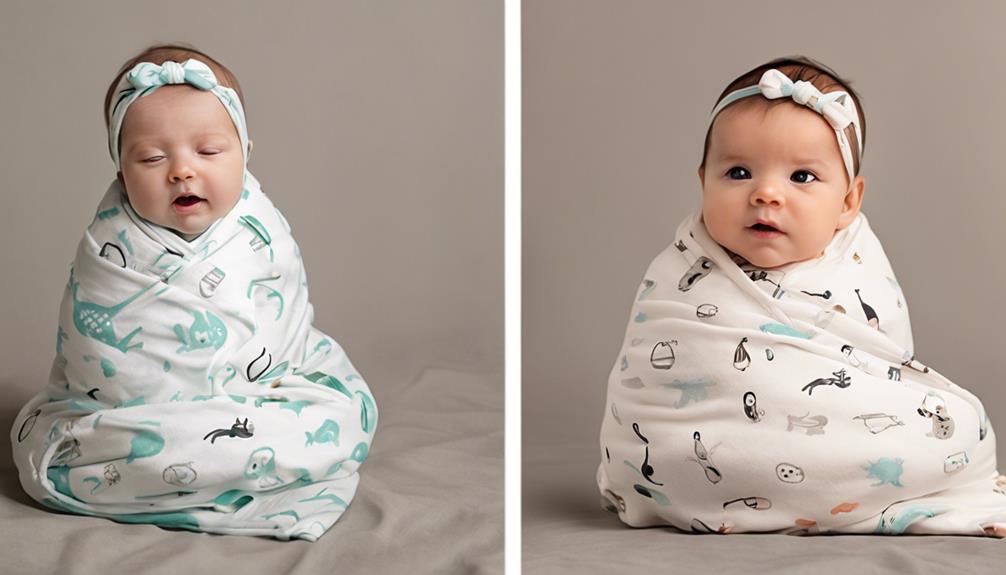
As new parents, we grasp the challenge of getting your newborn to sleep soundly. Did you know that swaddling can increase your baby's sleep duration by up to 50%?
Mastering the art of swaddling is vital for a peaceful night's rest, but where do you begin? Let's explore the five essential steps to swaddle your newborn effectively for improved sleep quality.
Key Takeaways
- Swaddle snugly to mimic the womb and prevent startle reflex.
- Prioritize breathable fabrics and secure fastenings for comfort.
- Position baby correctly for safe swaddling and hip development.
- Ensure safe practices by keeping swaddle loose around hips and legs.
Benefits of Swaddling Your Newborn
Swaddling your newborn provides a sense of security and comfort, mimicking the cozy environment of the womb and promoting better sleep. When you wrap your baby snugly in a swaddle, it helps them feel safe and secure, preventing the startle reflex that can disrupt their sleep. By keeping their arms close to their chest, swaddling creates a comforting cocoon that allows your infant to relax more easily, cry less, and settle into sleep more quickly.
Not only does swaddling benefit your baby by improving their sleep patterns, but it also aids in reducing the risk of Sudden Infant Death Syndrome (SIDS) by promoting safe sleep practices. As parents, we all want what's best for our little ones, and swaddling is a simple yet effective way to help them feel more at ease and content.
Choosing the Right Swaddle

When selecting the perfect swaddle for your newborn, prioritize breathable fabrics like cotton or muslin to prevent overheating. These materials are gentle on your baby's delicate skin and help regulate their body temperature, ensuring a comfortable sleep environment.
It's important to take into account the size of the swaddle blanket to securely wrap your newborn without being too loose or too tight. Opt for swaddle blankets with secure fastenings like Velcro or zippers for convenience and ease of use, making late-night diaper changes a breeze.
Look for designs that promote proper hip development by allowing your little one's legs to move freely within the swaddle. Remember, the swaddle should be snug but not restrictive, creating a cozy cocoon that mimics the feeling of being in the womb.
Step-by-Step Swaddling Guide
Gently lay your baby face-up at the folded corner of the swaddle blanket to begin the swaddling process. Make sure your little one's head is positioned neatly within the blanket as you wrap it snugly over their body, making sure to tuck it securely underneath.
Next, bring the bottom corner of the blanket up and over your baby's tiny feet, creating a cozy cocoon that's both comforting and secure. It's important to make certain their head is uncovered to promote proper airflow and regulate temperature, preventing any overheating.
Once the swaddle is in place, double-check to make certain it's firm but not too tight, allowing ample room for your baby's hips to move freely. This gentle wrapping technique can help your newborn feel safe and secure, mimicking the snug environment of the womb, which may lead to better sleep patterns for your infant.
Positioning Your Baby Correctly

To guarantee your newborn is positioned correctly for swaddling, begin by placing your baby face-up with their head nestled at the folded corner of the swaddle blanket. Here's how to position your baby step by step:
- Wrap Your Baby's Body Securely: Make sure the swaddle is tightly wrapped over your baby and tuck it underneath to ensure a secure fit.
- Fold the Top Corner: Bring the bottom corner of the swaddle blanket up over your baby's feet, allowing room for their hips to move comfortably.
- Position Your Baby's Arms Correctly: Start by placing your baby's left shoulder slightly below the top edge of the swaddle. Then, gently bring your baby's right arm down and across their body, securing it snugly in place before wrapping the swaddle.
Ensuring Safe Swaddling Practices
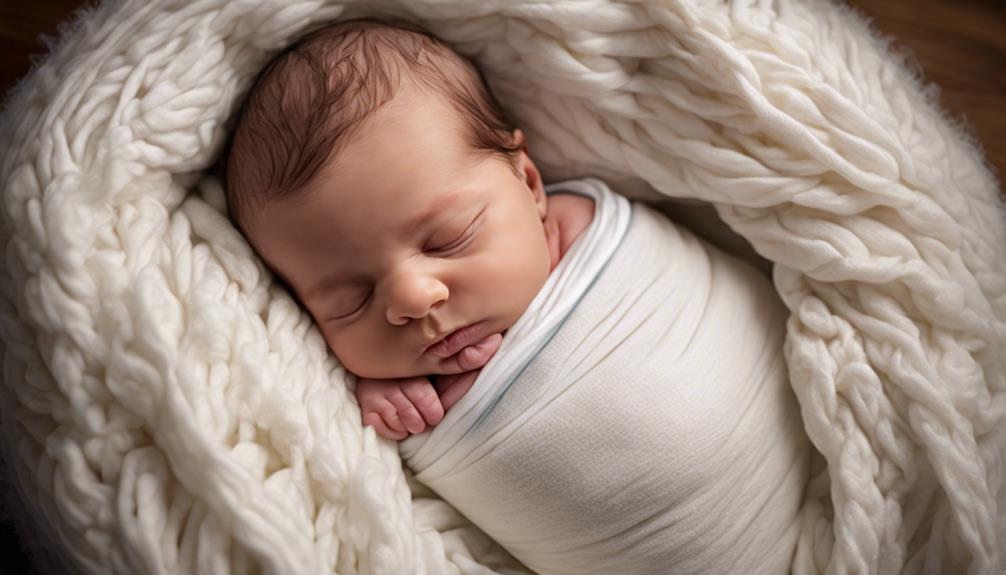
Ensuring the safety of your baby during swaddling is paramount for a restful and secure sleep environment. When you swaddle your baby, it's important to follow safe swaddling practices to reduce the risk of potential issues. One key point to remember is always placing your baby on their back to sleep, as recommended by the American Academy of Pediatrics, to lower the risk of Sudden Infant Death Syndrome (SIDS). Additionally, make sure that the swaddle is snug but not too tight around the hips and legs to prevent hip dysplasia. It's important to be mindful of your baby's comfort and body temperature while swaddled. Avoid covering their head with the swaddle to allow proper airflow. By swaddling your baby correctly and safely, you can provide them with a cozy and secure sleep environment.
| Safe Swaddling Practices | Tips |
|---|---|
| Back to Sleep | Reduces the risk of SIDS |
| Hips and Legs | Keep swaddle loose around hips |
| Moro Reflex | Swaddle snugly around the arms |
| Hip Dysplasia | Choose swaddles that allow leg movement |
Frequently Asked Questions
How Do I Get My Newborn to Sleep in a Swaddle?
We make swaddling cozy for newborns by gently wrapping them in a snug blanket, ensuring arms and torso are secure, but not too tight. Safety is key, allowing natural movement. Practice this to help babies feel secure and sleep better.
Does Swaddling Help Newborns Sleep Better?
Absolutely, swaddling is a game-changer for newborns' sleep. It's like wrapping them in a cozy hug, calming their startle reflex so they snooze longer and deeper. Our little one sleeps like a champ!
What Is the Best Position for a Swaddled Baby to Sleep?
Back sleeping is the best position for a swaddled baby to sleep. It diminishes the risk of SIDS, guarantees proper airflow, and helps regulate body temperature. Healthcare professionals recommend this position for safe and sound sleep.
Should You Swaddle Newborns Arms up or Down?
Swaddling newborns with their arms down is recommended for better sleep and security. It prevents startle reflexes, creating a cozy environment. Babies feel more settled and supported, improving sleep quality. It's a comforting practice for our little ones.
Conclusion
To sum up, swaddling your newborn can lead to better sleep and overall comfort for your little one.
Did you know that swaddled babies tend to wake up less frequently during the night?
By following the proper swaddling techniques and guidelines, you can create a soothing environment that promotes quality sleep for your baby.
Remember, safety is key when swaddling, so always make sure that your baby's head remains uncovered and they're positioned correctly.
Happy swaddling!
Pamela is the voice behind our vibrant community, fostering connections and conversations among parents. Her expertise in community engagement and personal experiences as a parent fuel her passion for creating a supportive space for all. Pamela believes that community is crucial for navigating the complexities of parenting, offering a place for sharing, learning, and growing together.
Sleep Training
Newborn Only Wants to Sleep on Me: 7 Tips for Parents
Keen to reclaim your sleep space from your newborn? These 7 tips will help you unlock the secret to independent slumber – read on to find out how!

So, your newborn has declared you as the designated sleep spot, huh? It can feel like a never-ending cycle of baby snuggles and sleepless nights, but fear not, we've got some tips to help you reclaim your personal space (and maybe even catch a few extra Z's).
From establishing a solid bedtime routine to introducing sleep-inducing techniques, these strategies could be the key to revealing the elusive domain of independent sleep for your little one.
Stay tuned to discover how these seven tips can transform your nighttime routine and bring sweet dreams back to your household.
Key Takeaways
- Establish a consistent sleep routine to teach newborn when to sleep and promote healthy habits.
- Create a sleep-inducing environment with dim lights and white noise for longer, quality sleep.
- Use swaddling techniques to mimic the womb, regulate body temperature, and promote uninterrupted sleep.
- Understand baby's wake windows, recognize tired signs, and create nap routines based on sleep cues.
Establishing a Sleep Routine
Establishing a consistent sleep routine is crucial for helping newborns learn when to sleep and promoting healthy sleep habits. Babies thrive on predictability, so incorporating calming activities like a warm bath, reading a bedtime story, or gentle massage can signal bedtime. These routines help your baby understand that it's time to wind down and prepare for sleep.
The consistency of a bedtime routine creates a sense of security and predictability, which aids in your baby's ability to self-soothe and fall asleep independently. When you follow a consistent routine, your baby learns to associate these activities with bedtime, making it easier for them to relax and drift off to sleep.
Creating a Sleep-Inducing Environment

When aiming to create a sleep-inducing environment for our newborns, we should dim the lights to foster calmness and comfort.
Ensuring the room is cozy and quiet can greatly aid in promoting restful sleep.
Utilizing a white noise machine can also provide a soothing background that helps babies stay asleep longer.
Dimming Lights for Calmness
To create a soothing atmosphere conducive to newborn sleep, consider dimming the lights to signal the body's natural production of melatonin, promoting relaxation and aiding in the onset of drowsiness. Dimming lights before bedtime can help regulate the circadian rhythm, leading to improved sleep quality and a smoother passage into restful slumber.
Reduced light levels create a calming ambiance ideal for promoting sleep and decreasing alertness, preparing your little one for a peaceful sleep. Here are a few simple tips to help you achieve the perfect sleep environment for your newborn:
- Use soft, warm lighting in the evening to signal bedtime.
- Install dimmer switches for adjustable light levels.
- Consider using blackout curtains to block out external light sources.
Comfortable and Cozy
Let's guarantee your newborn's sleep environment is cozy and comfortable, setting the stage for restful nights and peaceful naps.
Assure the room is dark, quiet, and kept at a comfortable temperature to promote deep sleep. Swaddles or sleep sacks can provide a sense of comfort and security, helping your baby feel snug and safe while sleeping.
Consider using white noise machines to create a soothing atmosphere that aids in sleep induction. Opt for gentle sleepsuits that are breathable and gentle on your baby's skin for added comfort.
Consistency is key, so using blackout curtains can help establish a conducive space for naps and nighttime sleep. Prioritize creating a cozy and secure sleep environment to help your newborn rest peacefully.
White Noise Machine
Creating a sleep-inducing environment with a white noise machine can greatly benefit your newborn's restful nights and peaceful naps. The consistent background sound provided by a white noise machine can effectively mask noises that may disrupt your baby's sleep, promoting relaxation and a quiet sleep environment. This steady sound can mimic the comforting sounds babies heard in the womb, signaling the brain that it's time to rest.
By utilizing a white noise machine, you can improve your baby's sleep quality by reducing night waking episodes. It's a practical and proven way to establish a soothing atmosphere that helps your little one drift off to sleep more easily and enjoy longer periods of uninterrupted rest.
- Mimics womb sounds for relaxation
- Reduces disruptions from external noises
- Signals brain to rest
Using Swaddling Techniques

Swaddling, a technique that mimics the snug feeling of the womb, is a valuable tool for promoting a sense of security and comfort for newborns. When done correctly, swaddling can prevent the Moro reflex, ensuring your baby stays asleep longer by reducing sudden waking. It also helps regulate your baby's body temperature, keeping them cozy and warm throughout the night. By providing this secure environment, swaddling can decrease the risk of Sudden Infant Death Syndrome (SIDS) and promote safe sleep practices. Additionally, swaddling has a calming effect on babies, leading to longer and uninterrupted sleep cycles, benefiting both the baby and parents.
| Benefits of Swaddling | Details |
|---|---|
| Mimics womb feeling | Promotes sense of security |
| Prevents Moro reflex | Reduces sudden waking |
| Regulates body temperature | Keeps baby comfortably warm |
Swaddling is a wonderful way to create a safe and comforting sleep environment for your little one, encouraging better sleep patterns and overall well-being.
Implementing White or Pink Noise

As we explore further ways to enhance your newborn's sleep environment, incorporating white or pink noise can be a beneficial strategy to promote deeper and more restful sleep for your little one. White or pink noise creates a soothing environment that mimics sounds babies heard in the womb, helping improve sleep quality and reduce disturbances throughout the night.
Here are some tips for implementing white or pink noise into your newborn's bedtime routine:
- Use a white noise machine or app to provide a constant, gentle sound that can mask other noises and lull your baby to sleep.
- Experiment with different volumes and types of white or pink noise to find what works best for your newborn's sleep patterns.
- Incorporate white or pink noise consistently as part of your baby's bedtime routine to establish a positive sleep association and promote longer, more restful sleep periods.
Understanding Baby's Wake Windows

Understanding your baby's wake windows is essential for optimizing their sleep routine and ensuring they get the rest they need to thrive. Babies, especially newborns, have short wake windows, typically lasting around 45-60 minutes before needing to nap. By paying attention to tired signs such as yawning, eye rubbing, or fussiness, you can better gauge when to put your baby down for a nap within this window.
To prevent overtiredness and promote better sleep, it's important to keep wake windows consistent and adjust them as your baby grows. This adjustment is important to meet their evolving sleep requirements and avoid disruptions in their sleep schedule.
Creating a nap routine based on your baby's sleep cues and wake windows can significantly contribute to establishing a healthy sleep pattern and enhancing overall sleep quality. By following these guidelines and being attentive to your baby's signals, you can help them get the rest they need for optimal development and well-being.
Introducing a Pacifier

Introducing a pacifier to your baby can be a comforting and beneficial addition to their sleep routine, promoting self-soothing behaviors and potentially reducing the risk of SIDS. Pacifiers offer a sense of comfort and security for babies, mimicking the feeling of being held close.
Here are some tips to help you introduce a pacifier effectively:
- Start Slow: Introduce the pacifier during naps or bedtime to help your baby associate it with sleep.
- Choose the Right Pacifier: Opt for a pacifier that's the correct size for your baby's age and development to assure comfort.
- Be Patient: Some babies may take time to adjust to a pacifier, so give them time to explore and get used to it.
Gradual Steps for Independent Sleep

When it comes to helping your newborn sleep independently, we suggest starting with a gentle bedtime routine.
Creating a familiar sleep environment and introducing a comforting intermediary object can also aid in this process.
These small steps can make a big difference in encouraging your baby to develop healthy independent sleeping habits.
Gentle Bedtime Routine
To establish a gentle bedtime routine for your newborn, gradually introduce calming activities like a warm bath, gentle massage, and soothing lullabies. Consistency in bedtime schedules helps signal to your baby that it's time to sleep. Implementing a wind-down period before bedtime can aid in relaxation and preparation for sleep.
Encouraging self-soothing by gradually reducing the need for being held during bedtime routines can promote independent sleep habits. Remember, these steps are about creating a soothing environment that encourages your baby to relax and feel secure as they drift off to sleep. By incorporating these elements into your routine, you can help your newborn learn to settle down and sleep more independently.
- Provide a warm bath
- Engage in a gentle massage
- Play calming lullabies
Familiar Sleep Environment
Shifting your newborn to independent slumber can be achieved through gradual steps focused on familiarizing them with the designated sleep environment. Starting with one nap a day in the bassinet or cot can help establish a routine and comfort in the new sleep space. By encouraging daily naps in the designated sleep area, your baby can begin to associate it with rest and relaxation. Consistent use of the bassinet or cot for most naps reinforces the change to independent sleeping habits. This approach creates a sense of familiarity and security for your little one, making the eventual full shift smoother. Remember, establishing a designated sleep space and routine is key to nurturing your baby's comfort and promoting independent sleeping habits.
| Familiar Sleep Environment | Benefits | Tips |
|---|---|---|
| Start with one nap a day in the bassinet or cot | Establishes routine and comfort | Begin with the first nap of the day |
| Encourage daily naps in the designated sleep space | Builds familiarity and routine | Aim for most naps in the bassinet or cot |
| Consistent use of the sleep space for naps | Reinforces shift to independent sleep | Maintain regularity for familiarity |
Comforting Transitional Object
After establishing a familiar sleep environment in the bassinet or cot, the next step towards self-reliant slumber involves introducing a comforting intermediary object to aid your baby's sense of security during sleep.
Here are some tips to help you navigate this phase:
- Choose Wisely: Select a comforting object like a soft blanket or toy that's safe and age-appropriate for your baby.
- Consistent Use: Incorporate the intermediary object into your baby's sleep routine consistently during naps and bedtime to create a positive association with independent sleeping.
- Bonding Time: Encourage your baby to bond with the intermediary object by including it in soothing rituals and bedtime routines for a smoother journey to independent sleep.
Conclusion
As parents maneuvering the challenging phase of a newborn who only wants to sleep on us, it's important to remember that patience and consistency are key.
By implementing the tips mentioned, we can gradually help our babies shift to independent sleep while still providing the comfort and reassurance they need.
Remember, Rome wasn't built in a day, so let's take it one step at a time and trust the process like planting seeds in a well-tended garden.
Nancy combines her love for writing with a deep understanding of the diverse dynamics of family life. As a parent, she brings personal experience and empathy to her work, covering topics from early childhood to the teenage years. Nancy’s work is driven by the belief that every family’s story is unique, and sharing these stories can inspire and support others on their parenting journey.
-

 Third Trimester2 months ago
Third Trimester2 months agoManaging Nausea in the Third Trimester: A How-To Guide
-

 Third Trimester2 months ago
Third Trimester2 months agoManaging Nausea During the Third Trimester: A How-To Guide
-

 Third Trimester2 months ago
Third Trimester2 months agoSafe Third Trimester Exercise Guide for Moms-to-Be
-

 Vetted2 months ago
Vetted2 months ago15 Best Newborn Zipper Onesies Every Parent Should Have in Their Baby's Wardrobe
-

 First Trimester4 weeks ago
First Trimester4 weeks agoDramamine Use in Pregnancy: First Trimester Guide
-

 Newborn Care1 month ago
Newborn Care1 month agoNewborn Care Basics: A Step-by-Step Guide
-

 First Trimester2 months ago
First Trimester2 months agoUsing Vicks Vaporub Safely During Pregnancy: First Trimester Guide
-

 First Trimester1 month ago
First Trimester1 month agoFirst Trimester Pregnancy: How to Monitor Poop Color Changes
